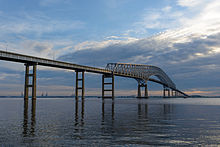Francis Scott Key Bridge (Baltimore)
| Francis Scott Key Bridge | |
|---|---|

The Francis Scott Key Bridge, viewed from Fort Armistead Park
|
|
| Coordinates | 39°13′09″N 76°31′31″W / 39.2192°N 76.5253°WCoordinates: 39°13′09″N 76°31′31″W / 39.2192°N 76.5253°W |
| Carries | 4 lanes of |
| Crosses | Patapsco River |
| Locale | Baltimore, Maryland |
| Maintained by | Maryland Transportation Authority |
| Characteristics | |
| Design | Steel Arch-Shaped Continuous Through Truss Bridge |
| Material | Steel |
| Total length | 8,636 feet (2,632.3 m; 1.6 mi) |
| Longest span | 1,200 feet (366 m) |
| Clearance above | 185 feet |
| History | |
| Construction begin | 1972 |
| Opened | March 23, 1977 |
| Statistics | |
| Toll | $4.00 |
The Francis Scott Key Bridge, also known as the Outer Harbor Bridge or simply the Key Bridge, is a Steel Arch-Shaped Continuous Through Truss Bridge spanning the Patapsco River in Baltimore, Maryland, USA. The main span of 1,200 feet (366 m) is the third longest span of any continuous truss in the world. It is also the longest bridge in the Baltimore area.
The bridge was opened in March 1977 and is named for the author of the Star Spangled Banner, Francis Scott Key. The bridge is the outermost of three toll crossings of Baltimore’s Harbor. Upon completion, the bridge structure and its approaches became the final links in Interstate 695 (the Baltimore Beltway). Despite the I-695 signage, the bridge is officially considered part of Maryland Route 695.
The span is 1,200 feet (366 m) long and carries an estimated 11.5 million vehicles annually. This bridge is a designated hazardous materials truck route, as HAZMATs are prohibited in the two tunnels.
The Key Bridge is a toll facility operated by the Maryland Transportation Authority. The toll rate for cars as of July 1, 2013 is $4.00. The bridge is also part of the E-ZPass system, and includes two dedicated E-ZPass lanes in its toll plaza in both the northbound and southbound directions.
In the 1960s, the Maryland Transportation Authority concluded there was a need for a second harbor crossing and began planning a single-tube tunnel under the Patapsco River, downstream from the Harbor Tunnel. The proposed site was between Hawkins Point and Sollers Point. Plans also were underway for a drawbridge over Curtis Creek to connect Hawkins Point to Sollers Point. (At the same time, a bridge was planned for the segment of I-95 that would run through the city near Fort McHenry; this was replaced by what is now known as the Fort McHenry Tunnel, a four-tube facility that opened in 1985.)
...
Wikipedia
